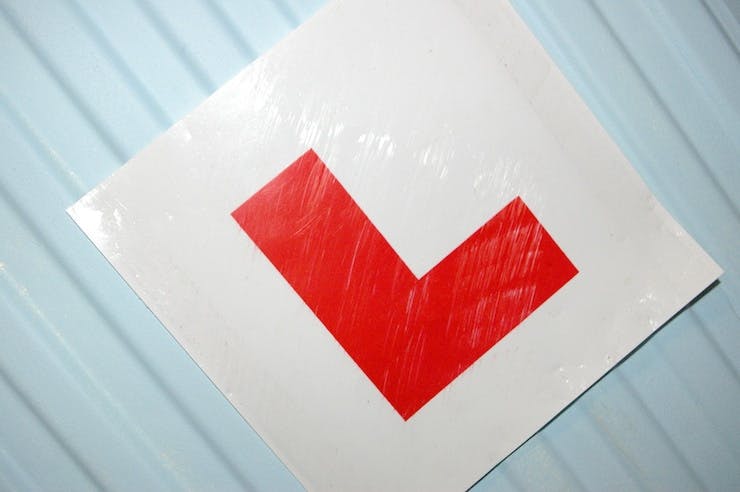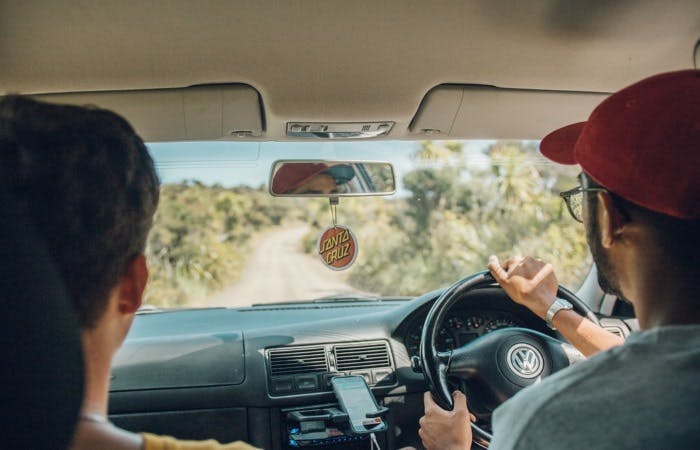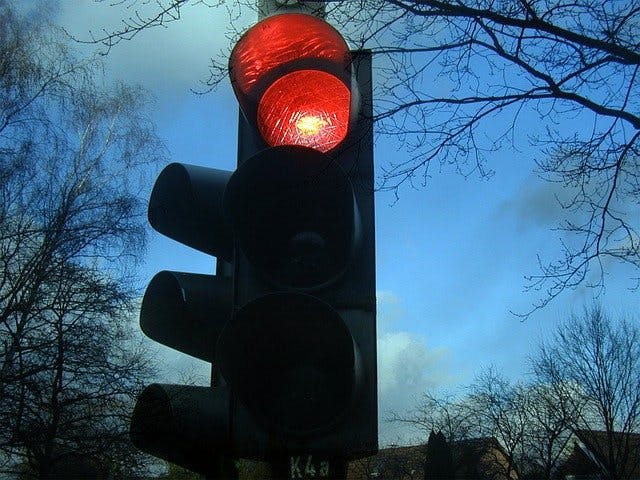
Rules aren't usually the most thrilling topic. The ones we're talking about today, however, are relatively exciting. At least, they are if you consider what they allow you to do. These laws are the ones that let you book your driving lessons, practice before your test and eventually get your full driving licence. Yep, you guessed it: they're the learner driver rules.
So grab a cuppa and take just a couple of minutes to get to grips with everything you're allowed to do before you pass your test. From what times of day you're able to drive, to who can sit alongside you as you practice, here are 10 learner driver rules you really need to know.
1. You've got to be legal
First off, you can’t drive on UK roads without a valid provisional licence. It proves that you're fit to drive, because in order to qualify for one, you need to confirm that you meet certain health and eyesight standards. Getting your provisional is quite a quick process—it usually takes just a couple of weeks to arrive. You'll have to pay £34 if you apply online, or £43 by post. Once your green card arrives, you’ll be able to book your theory test and get started on your driving lessons. It really is the gateway to independence.
2. L is for learner
Every learner driver in the UK has to have L plates (or D plates in Wales) on the car they are driving. That way, other drivers can identify you as someone with limited experience, and can adjust their own driving accordingly. It helps to take the pressure off you a bit, as other drivers will recognise that you might be more likely to stall at junctions or struggle with hill starts. They’ll probably give you a bit of extra space and be more patient if you make a mistake.
You’ll need two L plates on the car: one on the front and one on the back, and they must be a certain size and shape. Make sure yours meet the criteria, otherwise you can pick up points on your licence and potentially a fine.
3. You can carry passengers

Next up on the list of learner driver rules is one that might surprise you. Even on a provisional licence, you’re allowed to take passengers in the car with you. It doesn’t matter how old they are, so you can transport children if you want. Some instructors may even let you take your children with you on a driving lesson, although there are things you should think through when considering this.
Speaking of which, it’s totally up to you as to whether you feel comfortable carrying passengers full stop. Consider whether your passengers will put you under peer pressure, or if they’re likely to distract you. And be honest with yourself: are you ready for the extra responsibility? It’s best to get comfortable with your driving skills before you add in extra stress (and yes, stress means people).
The final thing on this point is to make sure your insurance is in line with your expectations. Some insurance companies go a little further than the law and restrict the age of your passengers, which you should bear in mind if you’re practising in the car between lessons.
4. You must be properly supervised
You can’t just take the car out for a practice on your own—there are specific rules about who can sit alongside you in the front passenger seat. That person has to be at least 21 years old and have held a full (i.e., not provisional) UK or EEA driving licence for at least 3 years. That licence needs to be relevant to the type of car you're driving; if you’re in a manual car, they need to have a manual licence.
All the rules that apply to you, as a driver, also apply to them. So, no breaking the alcohol limit and no looking at their phone—they're supervising you, and that requires full concentration at all times. For your sake, it’ll also help if they can keep their cool and give you the space to practise what you’ve learnt in your lessons. The last thing you need is to pick up someone else's bad driving habits before you’ve even had a chance to develop your own!
5. There's no curfew

There is no curfew for learner drivers in the UK, so (as long as your insurance permits it) you can drive at any time of the day or night. It’s good to get experience driving at different times, because poor visibility on the roads can get a bit of getting used to. As well as switching between your own sidelights, headlights and full beam, you'll also have to deal with the glare from other drivers' lights.
Familiar roads can suddenly look very different after dusk, and it can be more difficult to judge distances accurately when the sun's gone down. All in all, we'd recommend taking advantage of this learner driver rule if you can. If you're planning on doing just that, take a look at our top tips for staying safe in the dark.
6. Motorway lessons are go!
A few years ago, learners weren’t allowed to go on the motorway at all. That law changed in 2018, and you're now allowed to go on the motorway during a driving lesson, so long as you're with a fully qualified instructor (ADI) and in a car with dual controls. Motorways tend to cause learners a little anxiety: they have more lanes and higher speeds than other roads—and it can be tricky navigating slip roads.
For some, that’s all the more reason to get comfortable with them early on. On the other hand, it’s not the end of the world if you don’t manage to go on the motorway during your lessons. You'll probably have spent some time on dual carriageways, some of which are very similar to motorways. Remember, you can always take a Pass Plus course if you want some motorway-specific lessons after you’ve passed your test.
7. Insurance isn't optional
Learner driver rule number 7 is all about insurance. Yes, it's expensive; yes, we all like to complain about paying for it. But it's a serious offence to drive without insurance, and for good reason. It stops you having to fork out thousands of pounds in one go if you cause an accident, and your costs are covered if someone else hits you. Professional driving instructors are responsible for obtaining the relevant insurance, so it’s not something you need to worry about during your lessons. But if you go out in your own or someone else’s car in between times, you do need to make sure you are properly insured on it first.
Lots of companies offer learner drivers insurance—but there are various options and they can differ substantially in terms of cost. You might want to insure a car for just a couple of hours at a time, or you may prefer an option with more flexibility. Take a look at our guide to learner insurance to work out which type best suits your circumstances. Just make sure you're happy with any specific conditions your insurers impose on learners before you commit.
8. Sweet 17... usually

You might think you already know the driving age rules in the UK. And yes, you're right: for most people it is 17. But some people are able to start driving a little earlier. Anyone on the higher rate of DLA or PIP is allowed to drive on the roads at 16 instead. If you’re keen to get your licence as soon as possible, there are a few things that will help speed up the process:
- Apply for your provisional licence 3 months before you come of (driving) age
- Start revising for your theory test straight away, and book in for it as soon as you have your birthday
- Get a fast-tracked test and take a semi-intensive driving course to condense your learning time
9. Traffic laws don't discriminate
Just because you’re new to the world of driving, there's no slack in terms of following the rules of the road. You can still be punished for doing things wrong—so it’s really important that you get familiar with driving law as soon as possible.
Studying for your theory test is the best way to make sure you’re au fait with the rules of the road. Some of them are pretty obvious: driving under the influence, for instance, is a big no-no. But there are others you might not be aware of, like how much room you have to give a cyclist when you pass them. If you know that sort of stuff before you start your lessons, it'll help you keep out of trouble, stay safe and learn your practical skills more efficiently. That sounds like a no-brainer to us!
10. Paying for non-official lessons is against the law
Although most people choose to take driving lessons with a professional driving instructor, you don’t have to. However, if someone else teaches you to drive—a friend or family member, say, did you know that it’s actually illegal to pay them for it? It might sound a bit of a weird rule, but it helps to protect real driving instructors and stops people taking advantage of you.
Before you get all giddy about telling your Aunt Francesca that she'll just have to teach you for free, make sure you know what you're getting yourself into. Consider the advantages of a sitting beside a pro. Instructors usually have dual control cars, for one thing, and they're experienced in explaining the different manoeuvres. They are also fully up-to-date on the correct driving techniques, which your examiner will definitely be looking out for. And, of course, you don't risk a family feud if things get stressful in the car...
So there you have it. Now you're an expert on learner driver rules, you can concentrate on your technique behind the wheel. And fortunately, we've got plenty of pointers to help you on your way.
Subscribe for driving advice, offers & more
We'd love to let you know about our courses, news and offers via email. You may unsubscribe at any time.
Star Genie Limited trading as PassMeFast. Company number 10093359
Copyright © 2024 owned by Star Genie Limited
PassMeFast, Blue Tower, MediaCityUK, Salford, M50 2ST
